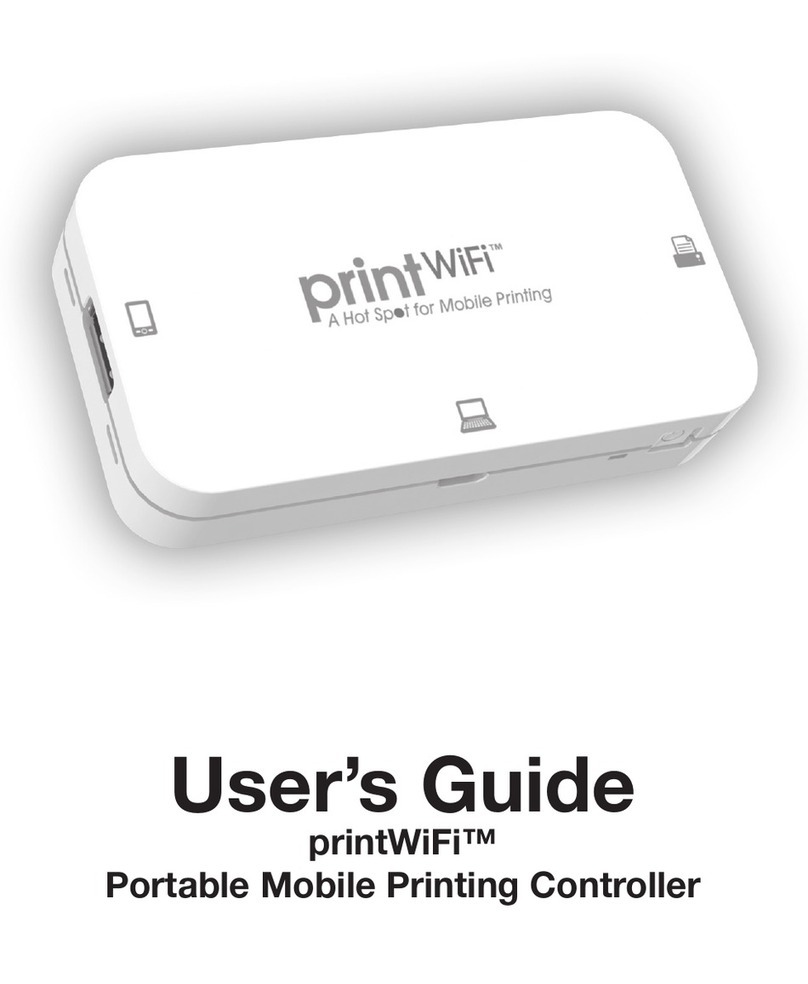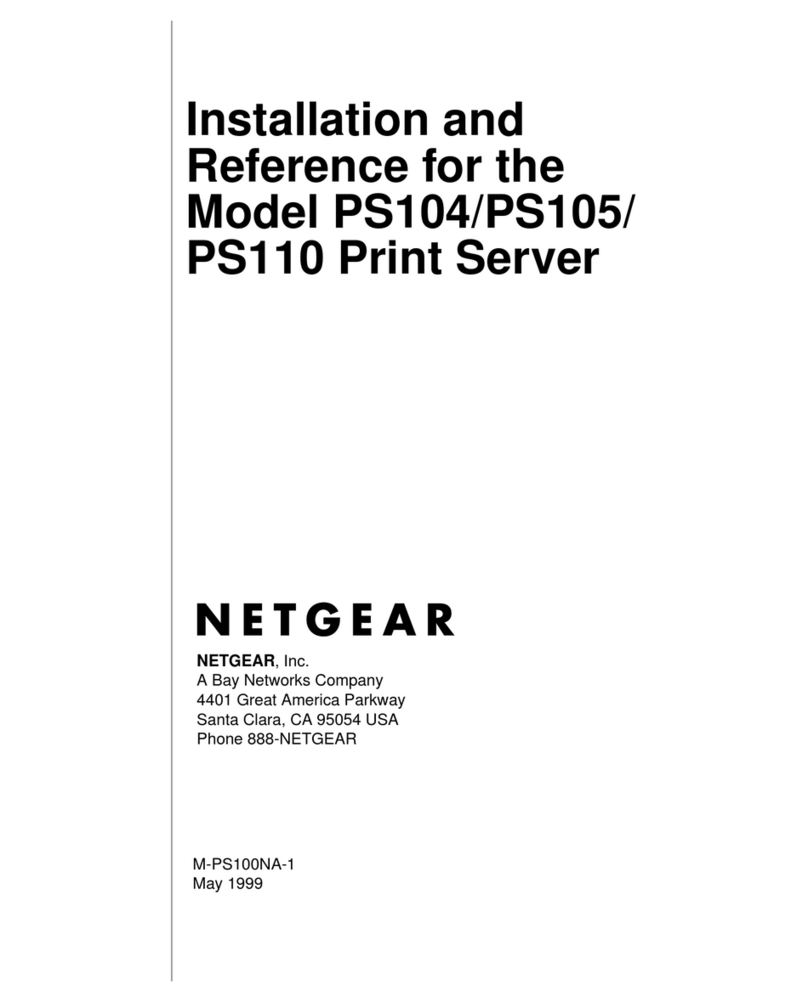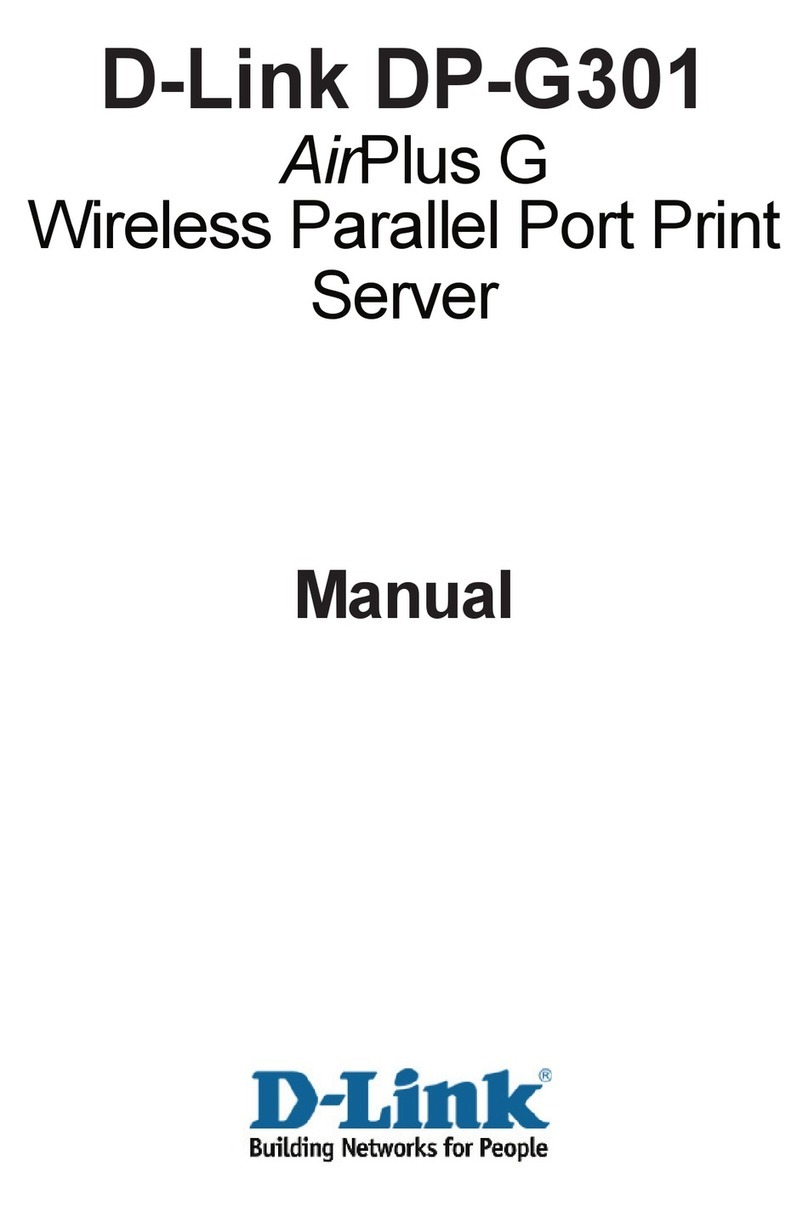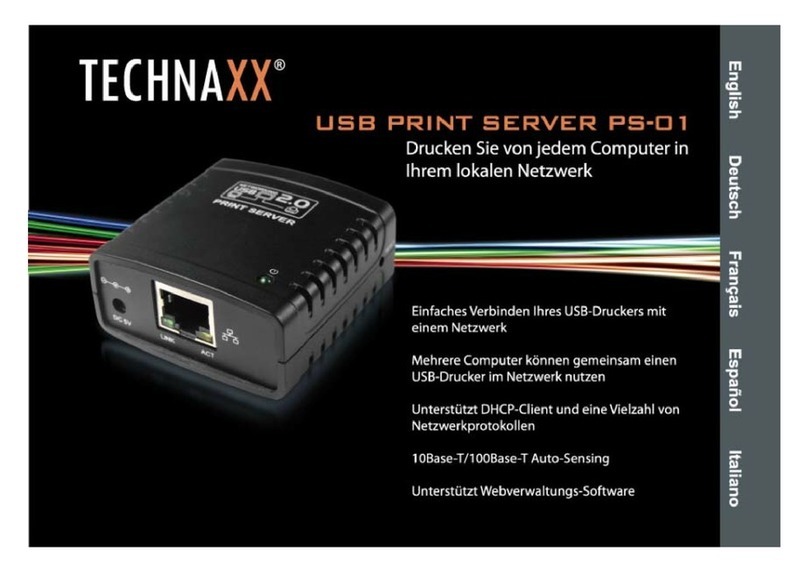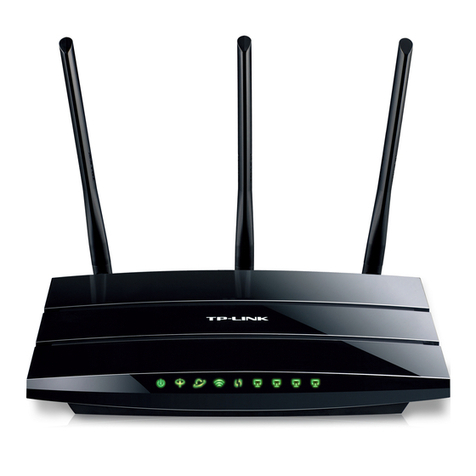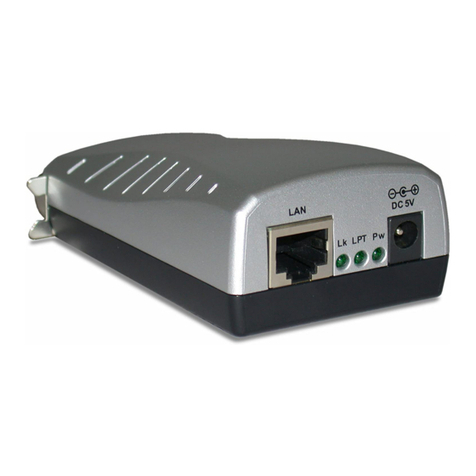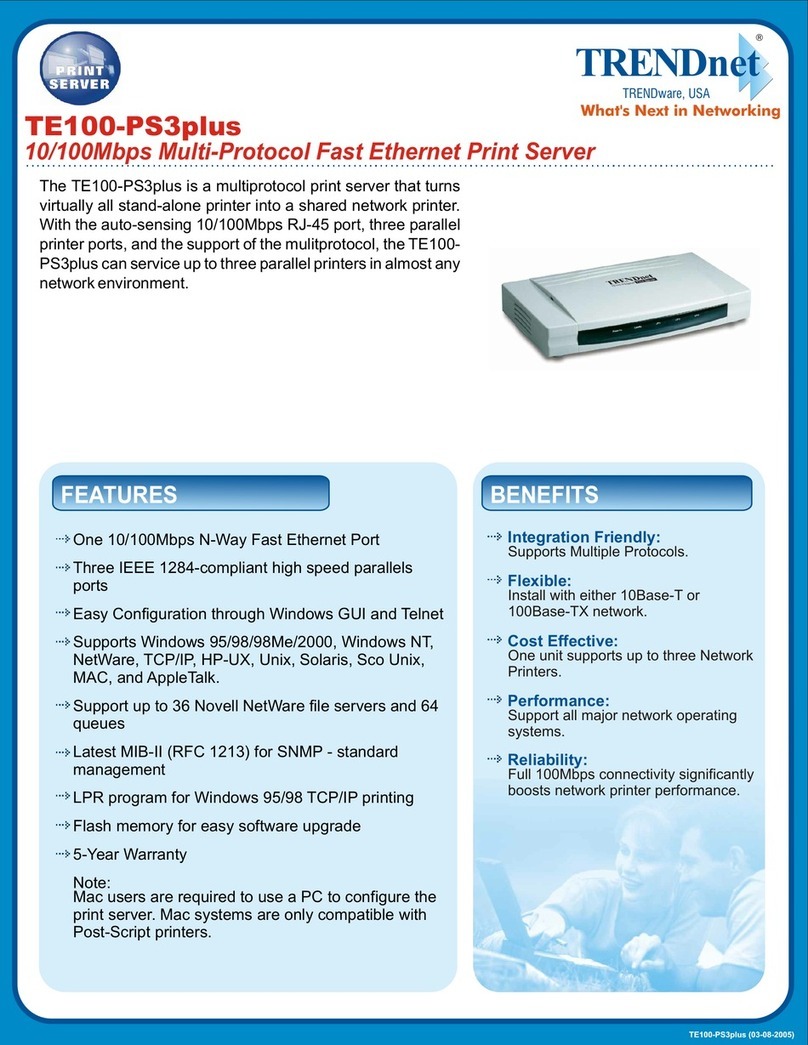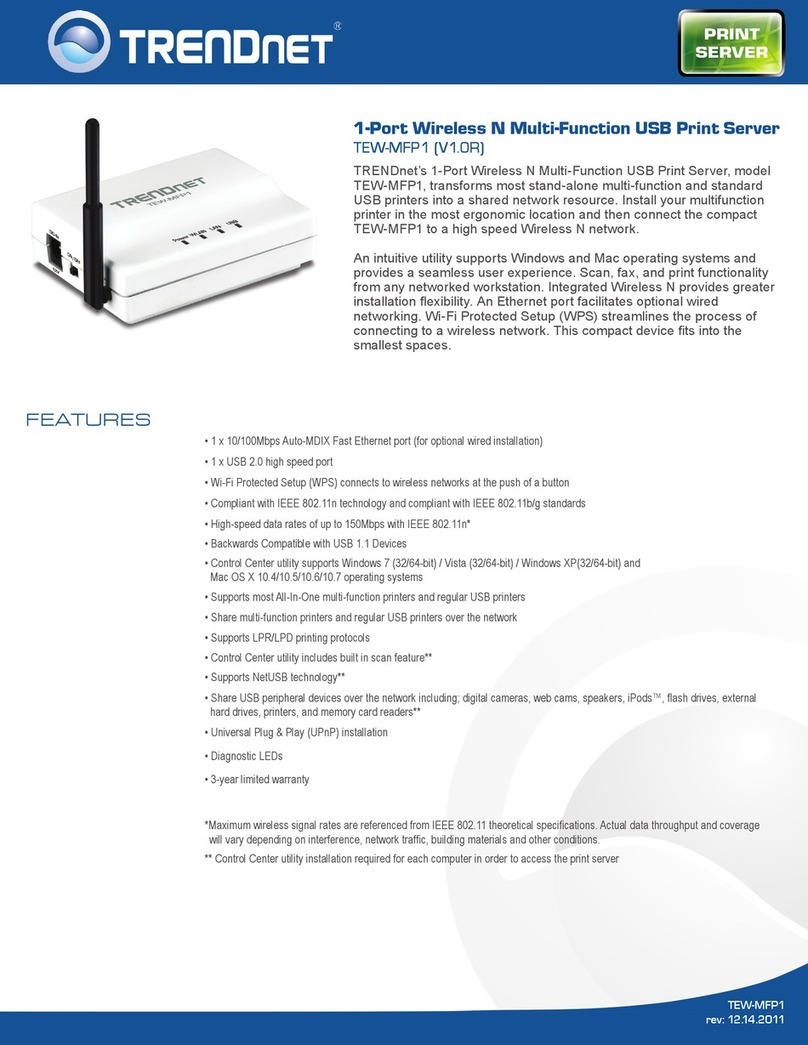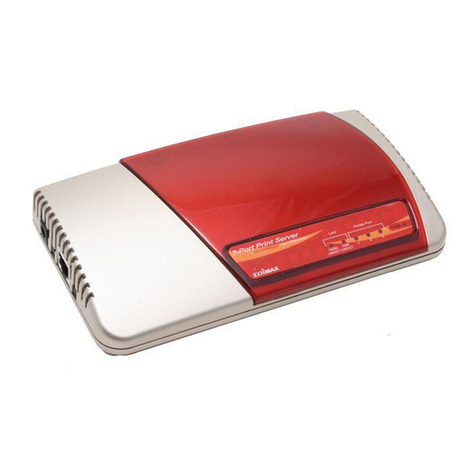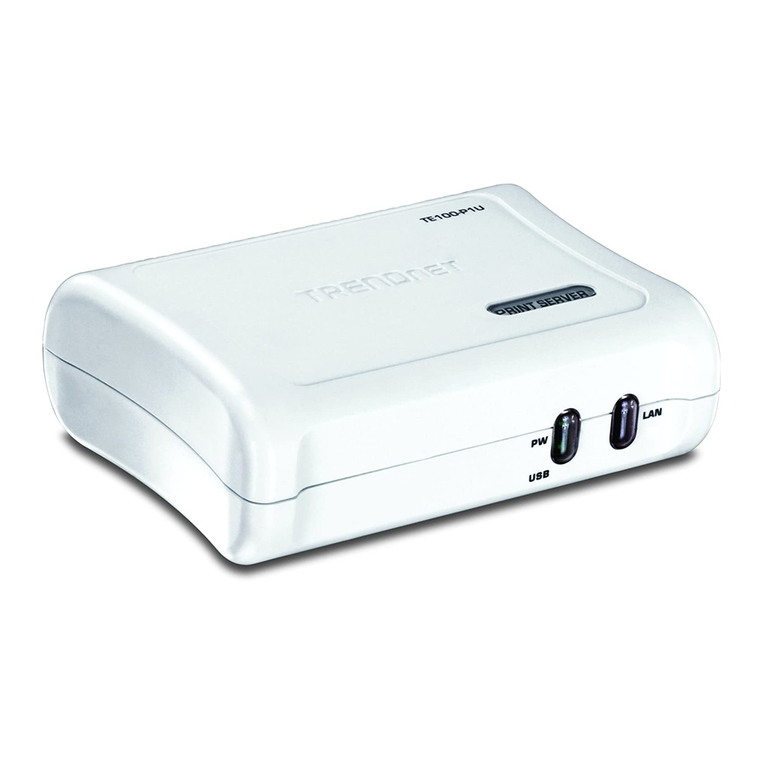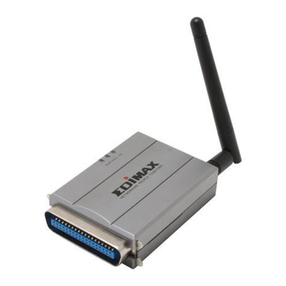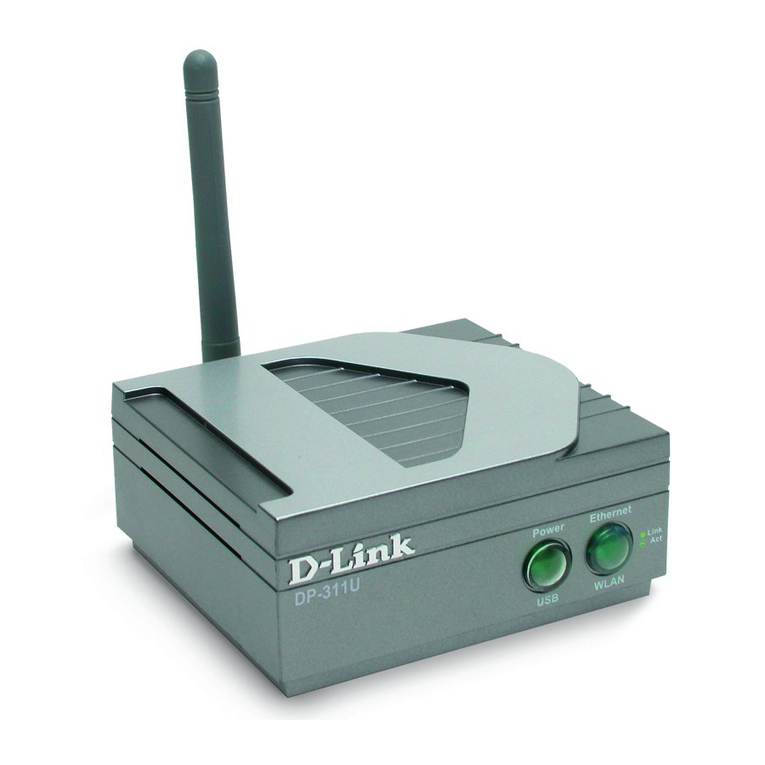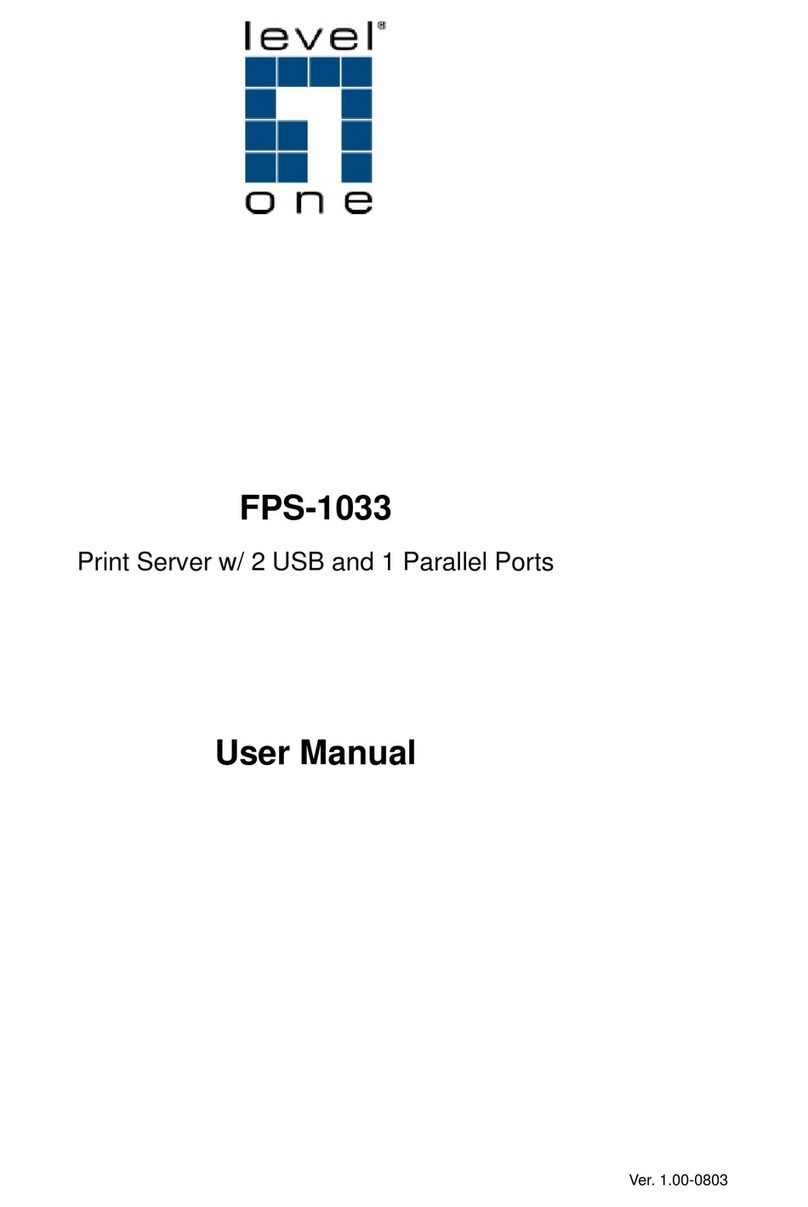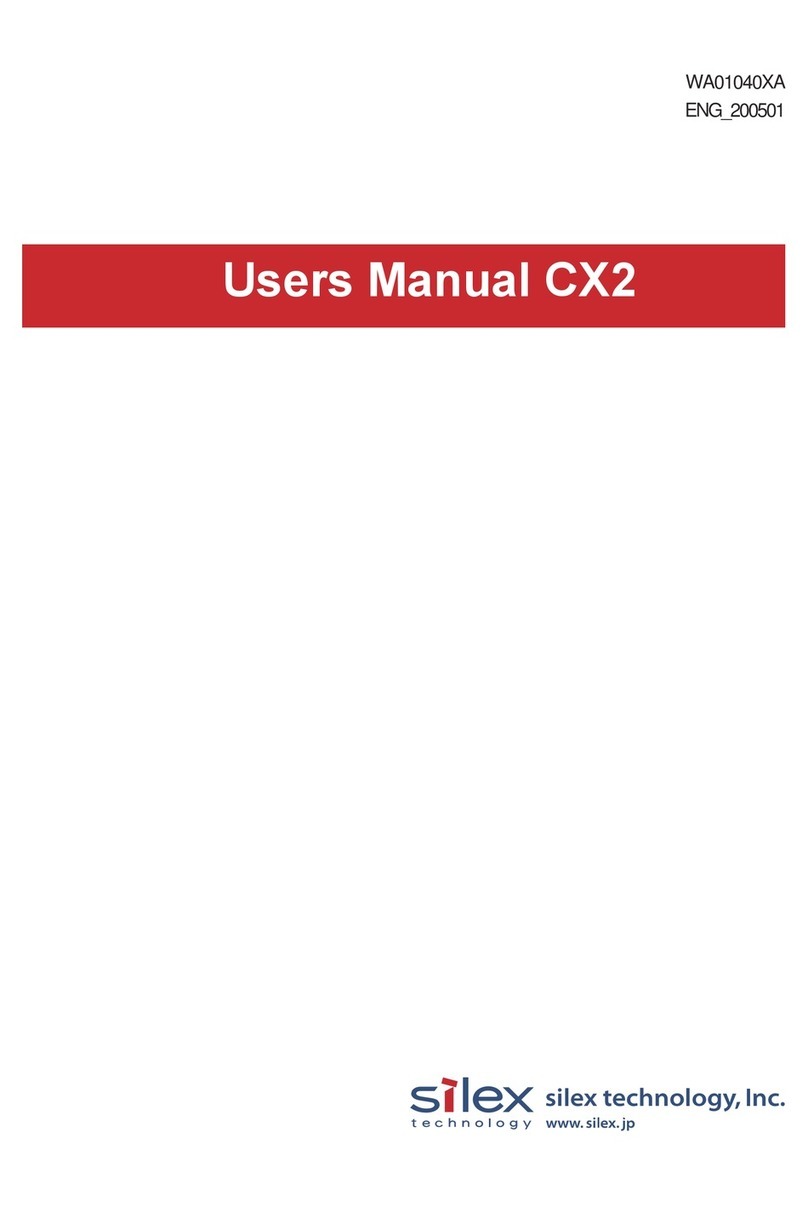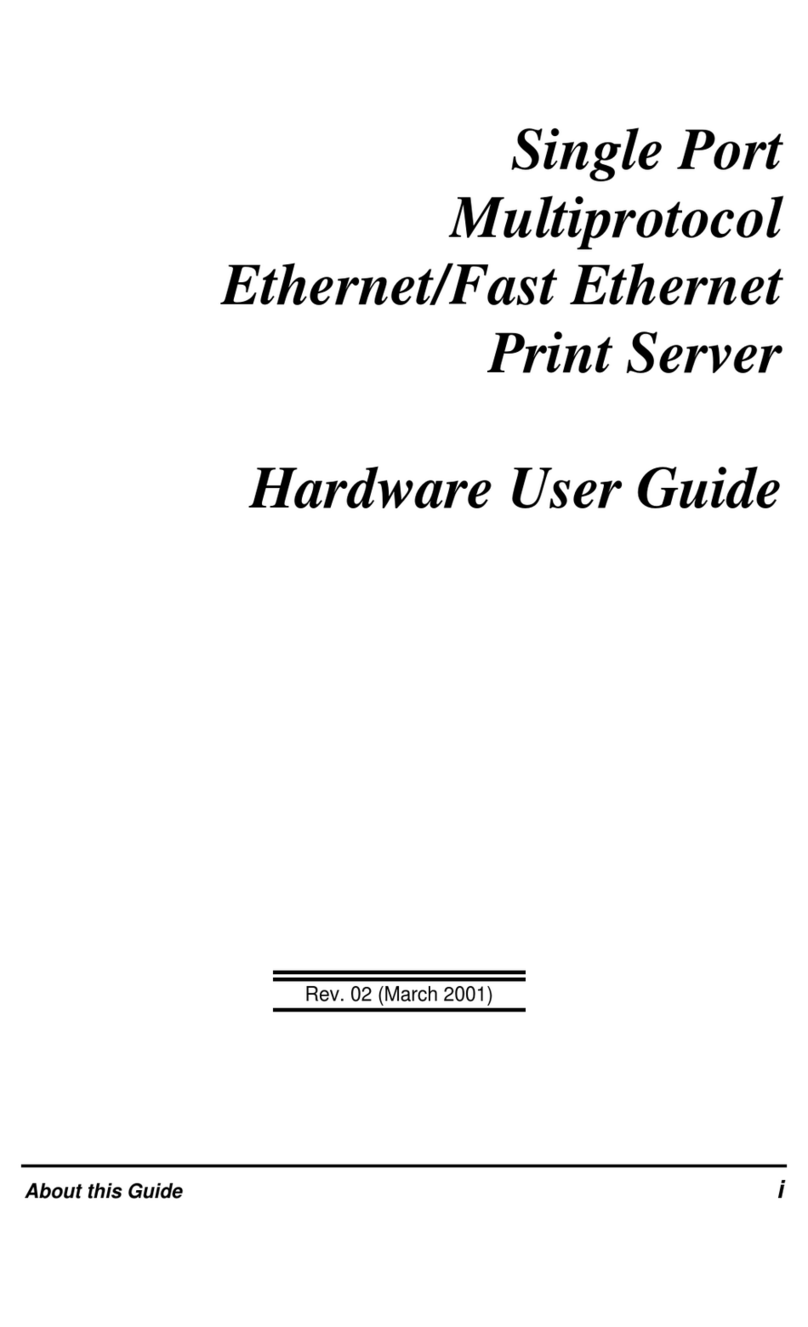Black Box PCA35A-R3 User manual

Order toll-free in the U.S. 24 hours, 7 A.M. Monday to midnight Friday: 877-877-BBOX
FREE technical support, 24 hours a day, 7 days a week: Call 724-746-5500 or fax 724-746-0746
Mail order: Black Box Corporation, 1000 Park Drive, Lawrence, PA 15055-1018
CUSTOMER
SUPPORT
INFORMATION
APRIL 1999
PCA35A-R3
PCA35AE-R2
PS035A
PS034E
PQ-6 PLUS (RO)
Receive-only printer interface for IBM®System 3X and AS/400
LINE
SYNC
DTR
DATA
OUT
TEST PWR
PQ-6 Plus (RO)
START STOP
TEST LF FF

PQ-6 PLUS (RO)
1
FEDERAL COMMUNICATIONS COMMISSION
AND
INDUSTRY CANADA
RADIO FREQUENCY INTERFERENCE STATEMENTS
This equipment generates, uses, and can radiate radio frequency energy and if not installed and used
properly, that is, in strict accordance with the manufacturer’s instructions, may cause interference to radio
communication. It has been tested and found to comply with the limits for a Class A computing device
in accordance with the specifications in Subpart J of Part 15 of FCC rules, which are designed to provide
reasonable protection against such interference when the equipment is operated in a commercial
environment. Operation of this equipment in a residential area is likely to cause interference, in which
case the user at his own expense will be required to take whatever measures may be necessary to correct
the interference.
Changes or modifications not expressly approved by the party responsible for compliance could void the
user’s authority to operate the equipment.
This digital apparatus does not exceed the Class A limits for radio noise emission from digital apparatus set out in the
Radio Interference Regulation of Industry Canada.
Le présent appareil numérique n’émet pas de bruits radioélectriques dépassant les limites applicables aux appareils
numériques de la classe A prescrites dans le Règlement sur le brouillage radioélectrique publié par Industrie Canada.

PQ-6 PLUS (RO)
2
INSTRUCCIONES DE SEGURIDAD (Normas Oficiales Mexicanas Electrical Safety Statement)
1. Todas las instrucciones de seguridad y operación deberán ser leídas antes de que el aparato eléctrico sea operado.
2. Las instrucciones de seguridad y operación deberán ser guardadas para referencia futura.
3. Todas las advertencias en el aparato eléctrico y en sus instrucciones de operación deben ser respetadas.
4. Todas las instrucciones de operación y uso deben ser seguidas.
5. El aparato eléctrico no deberá ser usado cerca del agua—por ejemplo, cerca de la tina de baño, lavabo, sótano
mojado o cerca de una alberca, etc..
6. El aparato eléctrico debe ser usado únicamente con carritos o pedestales que sean recomendados por el fabricante.
7. El aparato eléctrico debe ser montado a la pared o al techo sólo como sea recomendado por el fabricante.
8. Servicio—El usuario no debe intentar dar servicio al equipo eléctrico más allá a lo descrito en las instrucciones de
operación. Todo otro servicio deberá ser referido a personal de servicio calificado.
9. El aparato eléctrico debe ser situado de tal manera que su posición no interfiera su uso. La colocación del aparato
eléctrico sobre una cama, sofá, alfombra o superficie similar puede bloquea la ventilación, no se debe colocar en
libreros o gabinetes que impidan el flujo de aire por los orificios de ventilación.
10. El equipo eléctrico deber ser situado fuera del alcance de fuentes de calor como radiadores, registros de calor,
estufas u otros aparatos (incluyendo amplificadores) que producen calor.
11. El aparato eléctrico deberá ser connectado a una fuente de poder sólo del tipo descrito en el instructivo de
operación, o como se indique en el aparato.
12. Precaución debe ser tomada de tal manera que la tierra fisica y la polarización del equipo no sea eliminada.
13. Los cables de la fuente de poder deben ser guiados de tal manera que no sean pisados ni pellizcados por objetos
colocados sobre o contra ellos, poniendo particular atención a los contactos y receptáculos donde salen del aparato.
14. El equipo eléctrico debe ser limpiado únicamente de acuerdo a las recomendaciones del fabricante.
15. En caso de existir, una antena externa deberá ser localizada lejos de las lineas de energia.
16. El cable de corriente deberá ser desconectado del cuando el equipo no sea usado por un largo periodo de tiempo.
17. Cuidado debe ser tomado de tal manera que objectos liquidos no sean derramados sobre la cubierta u orificios de
ventilación.
18. Servicio por personal calificado deberá ser provisto cuando:
A: El cable de poder o el contacto ha sido dañado; u
B: Objectos han caído o líquido ha sido derramado dentro del aparato; o
C: El aparato ha sido expuesto a la lluvia; o
D: El aparato parece no operar normalmente o muestra un cambio en su desempeño; o
E: El aparato ha sido tirado o su cubierta ha sido dañada.

PQ-6 PLUS (RO)
3
TRADEMARKS
The trademarks mentioned in this manual are the sole property of their owners.

PQ-6 PLUS (RO)
4
CONTENTS
1. Specifications . . . . . . . . . . . . . . . . . . . . . . . . . . . . . . . . . . . . . . . . . . . . . . . . . . . . . . . . . . . . . . . . . . . . . . . . . . . . 5
2. Introduction . . . . . . . . . . . . . . . . . . . . . . . . . . . . . . . . . . . . . . . . . . . . . . . . . . . . . . . . . . . . . . . . . . . . . . . . . . . . . 6
2.1 Application . . . . . . . . . . . . . . . . . . . . . . . . . . . . . . . . . . . . . . . . . . . . . . . . . . . . . . . . . . . . . . . . . . . . . . . . . . . 6
2.2 Description . . . . . . . . . . . . . . . . . . . . . . . . . . . . . . . . . . . . . . . . . . . . . . . . . . . . . . . . . . . . . . . . . . . . . . . . . . . 6
3. Installation . . . . . . . . . . . . . . . . . . . . . . . . . . . . . . . . . . . . . . . . . . . . . . . . . . . . . . . . . . . . . . . . . . . . . . . . . . . . . . 8
3.1 Initial Setup . . . . . . . . . . . . . . . . . . . . . . . . . . . . . . . . . . . . . . . . . . . . . . . . . . . . . . . . . . . . . . . . . . . . . . . . . . 8
3.1.1 Installing a Supported Printer. . . . . . . . . . . . . . . . . . . . . . . . . . . . . . . . . . . . . . . . . . . . . . . . . . . . . . . 8
3.1.2 Power Supply and Grounding of the PQ-6 PLUS (RO) . . . . . . . . . . . . . . . . . . . . . . . . . . . . . . . . . 11
3.1.3 Off-Line Test of PQ-6 (RO) and Printer . . . . . . . . . . . . . . . . . . . . . . . . . . . . . . . . . . . . . . . . . . . . . . 12
3.2 System Configuration and Connection . . . . . . . . . . . . . . . . . . . . . . . . . . . . . . . . . . . . . . . . . . . . . . . . . . . 15
3.2.1 PQ-6 PLUS (RO) Address Selection . . . . . . . . . . . . . . . . . . . . . . . . . . . . . . . . . . . . . . . . . . . . . . . . . 15
3.2.2 System Configuration Reset. . . . . . . . . . . . . . . . . . . . . . . . . . . . . . . . . . . . . . . . . . . . . . . . . . . . . . . . 15
3.2.3 Printer Codes for Pitch and Density . . . . . . . . . . . . . . . . . . . . . . . . . . . . . . . . . . . . . . . . . . . . . . . . . 16
3.3 Placing the PQ-6 in Operation . . . . . . . . . . . . . . . . . . . . . . . . . . . . . . . . . . . . . . . . . . . . . . . . . . . . . . . . . . 16
4. Operation . . . . . . . . . . . . . . . . . . . . . . . . . . . . . . . . . . . . . . . . . . . . . . . . . . . . . . . . . . . . . . . . . . . . . . . . . . . . . . 18
4.1 Operator Controls and Indicators . . . . . . . . . . . . . . . . . . . . . . . . . . . . . . . . . . . . . . . . . . . . . . . . . . . . . . . 18
4.1.1 Function Switches. . . . . . . . . . . . . . . . . . . . . . . . . . . . . . . . . . . . . . . . . . . . . . . . . . . . . . . . . . . . . . . . 18
4.1.2 Indicator Lights . . . . . . . . . . . . . . . . . . . . . . . . . . . . . . . . . . . . . . . . . . . . . . . . . . . . . . . . . . . . . . . . . 19
4.2 Setup Mode. . . . . . . . . . . . . . . . . . . . . . . . . . . . . . . . . . . . . . . . . . . . . . . . . . . . . . . . . . . . . . . . . . . . . . . . . . 19
4.3 Command Pass Through . . . . . . . . . . . . . . . . . . . . . . . . . . . . . . . . . . . . . . . . . . . . . . . . . . . . . . . . . . . . . . . 21
4.4 Buffer Print Mode . . . . . . . . . . . . . . . . . . . . . . . . . . . . . . . . . . . . . . . . . . . . . . . . . . . . . . . . . . . . . . . . . . . . 22
4.4.1 Printout Format . . . . . . . . . . . . . . . . . . . . . . . . . . . . . . . . . . . . . . . . . . . . . . . . . . . . . . . . . . . . . . . . . 22
4.4.2 Data Interpretation . . . . . . . . . . . . . . . . . . . . . . . . . . . . . . . . . . . . . . . . . . . . . . . . . . . . . . . . . . . . . . 22
4.4.3 Notes . . . . . . . . . . . . . . . . . . . . . . . . . . . . . . . . . . . . . . . . . . . . . . . . . . . . . . . . . . . . . . . . . . . . . . . . . . 23
4.5 Functions and Options . . . . . . . . . . . . . . . . . . . . . . . . . . . . . . . . . . . . . . . . . . . . . . . . . . . . . . . . . . . . . . . . 23
Appendix A: PQ-6 PLUS (RO) EBCDIC to ASCII Translation Table. . . . . . . . . . . . . . . . . . . . . . . . . . . . . . . . . 25
Appendix B: Quick Reference Guide for PQ-6 PLUS (RO) . . . . . . . . . . . . . . . . . . . . . . . . . . . . . . . . . . . . . . . 28

PQ-6 PLUS (RO)
5
1. Specifications
Controls—PCA35A-R3, PCA35AE-R2: Reset, Start, Stop, LF, FF, Test
Speed—Serial port, 50 bps to 19.2 kbps
Interface—IBM twinaxial; RS-232/V.24 DCE asynchronous or Centronics type parallel
Connectors—(1) DB15 male with twinax V, (1) DB25 female
Indicators—(5) LEDs: DTR, Line Sync, Power, Test, Data Out
Temperature—Operating: 40 to 100 °F (5 to 42 °C);
Storage: -40 to 140 °F (-40 to 60 °C)
Humidity—0 to 95% noncondensing
MTBF—50,000 hours
Power—PCA35A-R2: 115-VAC, 60-Hz wallmount transformer (part number PS035A);
PCA35AE-R2: 230-VAC, 50-Hz (part number PS034E)
Size—PCA35A-R3, PCA35AE-R2: 2.1"H x 8.8"W x 11.5"D (5.3 x 22.4 x 29.2 cm)
Weight—PCA35A-R3, PCA35AE-R2: 4 lb. (1.9 kg)

PQ-6 PLUS (RO)
6
2. Introduction
2.1 Application
The PQ-6 PLUS (RO) is a “receive-only” microprocessor-based printer interface for the IBM System/34,
System/36, and System/38 computers. It allows a printer with an RS-232 or Centronics compatible port to
interface with IBM twinaxial cable via a male DB15 and twinax “pigtail” cable. Device address and serial or
parallel output are switch selectable, and the baud rate is selectable in 16 settings from 50 to 19,200 bps.
XON/XOFF and DTR are supported by the PQ-6 PLUS (RO) for buffer control. Data format is 7 bits, space
parity, 1 stop or 8 data bits, no parity, 1 stop bit.
2.2 Description
Data and commands are received from the twinax cable serially (1-MHz clock) by the proprietary front-end
processor of the PQ-6 PLUS (RO). Those commands and data addressed to the PQ-6 PLUS (RO) as
determined by the device address selection switches, are passed to the Z-80A microprocessor for further
processing. The Z-80A CPU converts EBCDIC to ASCII and makes the protocol conversions it needs to change
the high-speed synchronous twinax input into an asynchronous RS-232 ASCII output or Centronics compatible
output. You may bypass the EBCDIC to ASCII controller to the printer using the PQ-6 PLUS (RO) command-
passthrough feature (see Section 4.3).
Input data from the controlling host consists of data and command sequences normally interpreted by an
IBM 5256, 5224, and 5225 printer. In addition to printable characters and carriage-control characters (such as
new line, carriage return, and line feed), the controlling host can send command sequences to control output
format. These commands include page width, page length, characters-per-inch, and horizontal and vertical
carriage-positioning sequences. The PQ-6 PLUS (RO) interprets these command sequences and outputs ASCII
characters to perform the appropriate function. For example, when a form length command is received, the
value is stored internally in the PQ-6 PLUS (RO); when it receives a request for a form feed or for an absolute
move to line one of the next page, the PQ-6 PLUS (RO) will cause the paper in the attached printer to eject a
form of the previously specified form length. Since some commands issued to IBM printers cannot be easily
implemented on RS-232 ASCII printers, these commands are interpreted by the PQ-6 PLUS (RO) and
discarded. For example, a command to set the lines per inch to seventy-two is accepted by the PQ-6 PLUS
(RO), but no corresponding ASCII sequence is output, since the PQ-6 PLUS (RO) cannot know in advance
whether the attached printer can accommodate such a command and how to implement it.
As shipped from the factory, the PQ-6 PLUS (RO) is configured to emulate an IBM 5256 printer. If the PQ-6
PLUS (RO) is to emulate the 5224 or 5225 printer, you need to set the appropriate switch on the printed circuit
board (see Section 4.5).
Serial transmission speed is switch-selectable via printed-circuit-board switches, up to 19,200 bps. Output data
is asynchronous with one start bit, seven data bits, space parity, and one stop bit.
The PQ-6 PLUS (RO) supports both software flow control via XON/XOFF characters and hardware flow
control via the DTR RS-232 input lead. The PQ-6 PLUS (RO) will suspend printing whenever the DTR signal
drops and will resume printing when DTR is asserted. Similarly, when it receives an XOFF character (hex 13),
the PQ-6 PLUS (RO) suspends printing; when it receives an XON (hex 11), it will resume printing. Both
methods are always enabled. No configuration is required.

PQ-6 PLUS (RO)
7
The Centronics parallel interface is a 25-pin, parallel byte interface. It has eight lines that carry their
respective binary bits in parallel. The transmission of these data bits is controlled by the computer-supplied
STROBE pulse. Handshaking (flow control) is achieved by asserting or deasserting either the ACKNLG or
BUSY signal from the printer.
Figure 2-1. Typical Application.
S/3X, AS/400 or remote controller
PQ-6 PLUS (RO)
Printer
ASCII data serial
or parallel
Twinaxial
Serial EBCDIC
data and
commands
(1 MHz bit rate)

PQ-6 PLUS (RO)
8
3. Installation
The installation procedure is divided into three sections:
•Section 3.1, Initial Setup, explains how to position the PQ-6 (RO) after unpacking it, plug in the power
supply, and run off-line tests.
•Section 3.2, System Configuration and Connection, covers the considerations for setting up the PQ-6 PLUS
(RO). Items covered include setting the device address and all corresponding physical connections.
•Section 3.3, Placing the PQ-6 PLUS (RO) into Operation, details online testing procedures that you should
implement after completely installing the unit. This section also contains recovery procedures that you can
use if the PQ-6 PLUS (RO) malfunctions.
3.1 Initial Setup
3.1.1 INSTALLING A SUPPORTED PRINTER
CAUTION
Connecting a device to the DB25 connector without properly configuring the P3
jumper inside the box may cause damage to the PQ-6 PLUS (RO) and/or the attached
device.

PQ-6 PLUS (RO)
9
Figure 3-1. Board Layout.
Reset Power
DB25 Female DB15 Male
Serial
Parallel
+5 Ground
EPROM
Test Data Out DTR Line Sync Power
ON
SW1
1 2 3 4 5 6 7 8 1 2 3 4 5 6 7 8
SW2

PQ-6 PLUS (RO)
10
Installing an RS-232 Printer
Connect the 6-pin connector from the power supply to the 6-pin connector on the back of the PQ-6 PLUS
(RO). Remove the top cover of the PQ-6 PLUS (RO). Do not plug it into the AC outlet at this time. Locate
switch SW1 to set the baud rate and port configuration. Select the serial transmission speed (baud rate) for the
PQ-6 PLUS (RO) output port using the four switches labeled Rate 4, Rate 3, Rate 2, and Rate 1 on the printed
circuit board according to Table 3-1.
Table 3-1. Baud Rate.
Switch Baud Rate
S5 S6 S7 S8
OFF OFF OFF OFF 50
0=OFF OFF OFF OFF ON 75
1=ON OFF OFF ON OFF 110
OFF OFF ON ON 134.5
OFF ON OFF OFF 150
OFF ON OFF ON 300
OFFONONOFF600
OFF ON ON ON 1200
ON OFF OFF OFF 1800
ON OFF OFF ON 2000
ON OFF ON OFF 2400
ON OFF ON ON 3600
ON ON OFF OFF 4800
ON ON OFF ON 7200
ON ON ON OFF 9600
ON ON ON ON 19200
Select the port configuration for RS-232 serial operation by setting Opt 3 to the “ON” position.
Place the large internal jumper strip on P3 (P2 on boards with revision levels below C) in the “B-C” position
to select RS-232 output. Make sure that the cable to the PQ-6 PLUS (RO) is wired for DCE and contains wires
for pins 1, 2, 3, 7, and 20, connecting at the PQ-6 PLUS (RO) with a male DB25 connector. The signals are
shown in Table 3-2.
Table 3-2. Signals on the DCE cable.
Pin Signal Name Source
1 Chassis Ground —
2 Receive Data Printer
3 Transmit Data PQ-6 PLUS (RO)
7 Signal Ground —
20 Data Terminal Ready Printer
Place the supported printer close to the PQ-6 PLUS (RO). Connect the printer RS-232 cable to the DB25
connector on the back panel of the PQ-6 PLUS (RO). Proceed to Section 3.2.3.

PQ-6 PLUS (RO)
11
Installing a Centronics compatible printer
Connect the 6-pin connector from the power supply to the 6-pin connector on the back of the PQ-6 PLUS
(RO). Do not plug it into the AC outlet at this time.
Place the large jumper strip at P3, in the “A-B” position for parallel output.
The Centronics DB25 pinout is a standard DB25 to Centronics cable (Black Box part number EYN600) that
connects the PC to the printer. This cable’s pinning is shown in Table 3-3.
Table 3-3. Centronics to RS-232 Cable Wiring.
Pin No. Signal Source Description
1 Strobe PQ-6 PLUS (RO) Data strobe pulse to printer.
2 Data 1 PQ-6 PLUS (RO)
3 Data 2 PQ-6 PLUS (RO) 8 bits of parallel data.
4 Data 3 PQ-6 PLUS (RO)
5 Data 4 PQ-6 PLUS (RO)
6 Data 5 PQ-6 PLUS (RO)
7 Data 6 PQ-6 PLUS (RO)
8 Data 7 PQ-6 PLUS (RO)
9 Data 8 PQ-6 PLUS (RO)
10 Acknlg Printer Indicates data received and ready to accept other
data.
11 Busy Printer Indicates printer cannot receive data.
12 Paper End Printer Indicates out of paper.
13 Select Printer Indicates printer is selected and ready to receive
data.
14 Auto Feed PQ-6 PLUS (RO) When this signal is low (Jumper J1), the paper is
automatically fed one line after printing. This
signal does not apply to all printers.
15 Fault Printer Indicates a printer fault condition such as out of
paper.
16 Input PQ-6 PLUS (RO) Clears the printer buffer and initializes the logic.
18, 19, Ground PQ-6 PLUS (RO) Logic ground.
23, 25
Connect the Centronics printer cable to the DB25 connector at the back of the PQ-6 PLUS (RO). Locate
SW1 and set switch option 3 (position 2) to the “OFF” position.
3.1.2 POWER AND GROUNDING OF PQ-6 PLUS (RO)
Plug the power supply into a suitably grounded AC receptacle.

PQ-6 PLUS (RO)
12
3.1.3 OFF-LINE TEST OF PQ-6 PLUS (RO) AND PRINTER
Initial Power On Test
Once both the printer and the PQ-6 PLUS (RO) are plugged into the AC line, turn the printer power switch
“ON” and put it into an “on-line” condition. Make sure the connection between the printer and the PQ-6 PLUS
(RO) is complete. Run the following test to check the power and connections for both devices.
Table 3-4. Initial Test.
Initial Test Device Response Corrective Action
Plug the PQ-6 (RO) PLUS Power and DTR indicators. Proper response. No corrective
power supply into the AC line. action is necessary.
No response on power or Power supply not plugged into back
DTR indicators. connector of the PQ-6 (RO), or no AC
line power, or PQ-6 (RO) power supply
is defective.
DTR indicator blinking. If configured for serial: The attached
serial device is not providing Data
Terminal Ready (DTR) on Pin 20 of the
PQ-6’s DB25 connector. If configured for
parallel: The attached parallel printer is
not providing the select signal on Pin 13
of the PQ-6’s DB25 connector. Check
that the printer is “ON,” on-line, and the
cable is connected and configured
properly.

PQ-6 PLUS (RO)
13
Self-Test
After running the power test successfully, you can run the self-test to check the PQ-6 PLUS (RO) program
memory (ROM) and buffer memory (RAM). You can perform the self-test via two different methods: internal
DIP switches or the front-panel test button. Either way, the printer will print the software revision level, address
selected, and printer emulated. The self-test will also send a printed barber-pole test pattern to the printer. The
amount of data in the barber pole is different between the two types of self-tests. The self-test procedures and
device response are shown in Table 3-5. Figure 3-1 illustrates a sample of a self-test printout.
Table 3-5. Self-Test Procedures and Device Responses.
Preliminary Initial Device Corrective
Condition Test Response Action
Both PQ-6 PLUS (RO) Two methods of 1. Printed verification 1. Proper response. No
and printer are “ON” performing the occurs as described corrective action necessary.
and the “Power ON” self-test: via switches above.
test has been or via the front-panel
conducted test button
successfully. Switch method: Set
SW2-4 ON, SW2-5 ON,
then press and release
the reset button on the
rear of the unit.
Front-panel method:
Press the front-panel
test button.
When performing either
method of self-test, the
front-panel LEDs will
flash once, then the
Data Out LED will
flash rapidly
(depending on the
baud rate if serial)
while data is being
sent to the attached
printer.
2. No response 2. Check that the printer is
from printer or random on-line and the cable is
or garbage characters configured properly. Incorrect
are printed. baud rate, parity, or stop bits if
using serial interface.
3. Printed verification 3. Locate Jumper (J1) on PC
has blank line between board and position jumper from
printed lines. the +5V pin to the center pin.
After the self-test is successfully performed, set SW2 position 5 to “OFF” and press the reset switch.

PQ-6 PLUS (RO)
14
PQ6.PLUS
REV1.41 SOFTWARE
RAM OK
ROM OK
DEVICE ADDRESS 0
Printer = 5256
.<(+|& !$*);^-/,%>? -:#@'="abcdefghi jklmnopqr -stuvwxyz {ABCDEFGHI }JKLMNOPQ
<(+|& !$*);^-/,%>? -:#@'="abcdefghi jklmnopqr -stuvwxyz {ABCDEFGHI }JKLMNOPQ
.<(+|& !$*);^-/ ,%>? -:#@'="abcdefghi jklmnopqr -stuvwxyz {ABCDEFGHI }JKLMNOPQ
<(+|& !$*);^-/ ,%>? -:#@'="abcdefghi jklmnopqr -stuvwxyz {ABCDEFGHI }JKLMNOPQR
<(+|& !$*);^-/ ,%>? -:#@'="abcdefghi jklmnopqr -stuvwxyz {ABCDEFGHI }JKLMNOPQR
.<(+|& !$*);^-/ ,%>? -:#@'="abcdefghi jklmnopqr -stuvwxyz {ABCDEFGHI }JKLMNOPQR
<(+|& !$*);^-/ ,%>? -:#@'="abcdefghi jklmnopqr -stuvwxyz {ABCDEFGHI }JKLMNOPQR
+\& !$*);^-/ ,%>? -:#@'="abcdefghi jklmnopqr -stuvwxyz {ABCDEFGHI }JKLMNOPQR
& !$*);^-/ ,%>? -:#@'="abcdefghi jklmnopqr -stuvwxyz {ABCDEFGHI }JKLMNOPQR
!$*);^-/ ,%>? -:#@'="abcdefghi jklmnopqr -stuvwxyz {ABCDEFGHI }JKLMNOPQR
!$*);^-/ ,%>? -:#@'="abcdefghi jklmnopqr -stuvwxyz {ABCDEFGHI }JKLMNOPQR
!$*);^-/ ,%>? -:#@'="abcdefghi jklmnopqr -stuvwxyz {ABCDEFGHI }JKLMNOPQR
!$*);^-/ ,%>? -:#@'="abcdefghi jklmnopqr -stuvwxyz {ABCDEFGHI }JKLMNOPQR
!$*);^-/ ,%>? -:#@'="abcdefghi jklmnopqr -stuvwxyz {ABCDEFGHI }JKLMNOPQR
*);^-/ ,%>? -:#@'="abcdefghi jklmnopqr -stuvwxyz {ABCDEFGHI }JKLMNOPQR
^-/ ,%>? -:#@'="abcdefghi jklmnopqr -stuvwxyz {ABCDEFGHI }JKLMNOPQR
-/ ,%>? -:#@'="abcdefghi jklmnopqr -stuvwxyz {ABCDEFGHI }JKLMNOPQR
,%>? -:#@'="abcdefghijklmnopqr -stuvwxyz {ABCDEFGHI }JKLMNOPQR
,%>? -:#@'="abcdefghijklmnopqr -stuvwxyz {ABCDEFGHI }JKLMNOPQR
,%>? -:#@'="abcdefghijklmnopqr -stuvwxyz {ABCDEFGHI }JKLMNOPQR
,%>? -:#@'="abcdefghijklmnopqr -stuvwxyz {ABCDEFGHI }JKLMNOPQR
,%>? -:#@'="abcdefghijklmnopqr -stuvwxyz {ABCDEFGHI }JKLMNOPQR
%>? -:#@'="abcdefghijklmnopqr -stuvwxyz {ABCDEFGHI }JKLMNOPQR
>? -:#@'="abcdefghi jklmnopqr -stuvwxyz {ABCDEFGHI }JKLMNOPQR
-:#@'="abcdefghi jklmnopqr -stuvwxyz {ABCDEFGHI }JKLMNOPQR
-:#@'="abcdefghi jklmnopqr -stuvwxyz {ABCDEFGHI }JKLMNOPQR
-:#@'="abcdefghi jklmnopqr -stuvwxyz {ABCDEFGHI }JKLMNOPQR
-:#@'="abcdefghi jklmnopqr -stuvwxyz {ABCDEFGHI }JKLMNOPQR
-:#@'="abcdefghijklmnopqr -stuvwxyz {ABCDEFGHI }JKLMNOPQR
-:#@'="abcdefghijklmnopqr -stuvwxyz {ABCDEFGHI }JKLMNOPQR
-:#@'="abcdefghijklmnopqr -stuvwxyz {ABCDEFGHI }JKLMNOPQ
:#@'="abcdefghijklmnopqr -stuvwxyz {ABCDEFGHI }JKLMNOPQR
@'=" abcdefghijklmnopqr -stuvwxyz {ABCDEFGHI }JKLMNOPQR
=" abcdefghijklmnopqr -stuvwxyz {ABCDEFGHI }JKLMNOPQR
abcdefghijklmnopqr -stuvwxyz {ABCDEFGHI }JKLMNOPQR
bcdefghijklmnopqr -stuvwxyz {ABCDEFGHI }JKLMNOPQR
defghijklmnopqr -stuvwxyz {ABCDEFGHI }JKLMNOPQR
fghijklmnopqr -stuvwxyz {ABCDEFGHI }JKLMNOPQR
hijklmnopqr -stuvwxyz {ABCDEFGHI }JKLMNOPQR
jklmnopqr -stuvwxyz {ABCDEFGHI }JKLMNOPQR
jklmnopqr -stuvwxyz {ABCDEFGHI }JKLMNOPQR
jklmnopqr -stuvwxyz {ABCDEFGHI }JKLMNOPQR
jklmnopqr -stuvwxyz {ABCDEFGHI }JKLMNOPQR
klmnopqr -stuvwxyz {ABCDEFGHI }JKLMNOPQR
Figure 3-1. Sample Self-Test Printout.

PQ-6 PLUS (RO)
15
3.2 System Configuration and Connection
At this point, the PQ-6 PLUS (RO)’s serial or parallel port has been tested off-line and verified to be in working
condition. However, before attaching to the host system, you must consider the overall system layout to establish
the relative device positioning, port selection, cabling, device addressing, and unit identification.
3.2.1 PQ-6 PLUS (RO) ADDRESS SELECTION
Determine the correct device address number for the PQ-6 to use by contacting the person responsible for
assigning workstation and device addresses.
Locate the printer-options/address-selection DIP switches by removing the top half of the enclosure. The
switches are labeled SW2: ADR4 (POS 6), ADR2 (POS 7), and ADR1 (POS 8).
Set the three switches on the right of the DIP switch to arrive at the proper twinax address. When the switch
is OFF, it represents a zero. Conversely, when the switch is ON, it represents a one. The three switches are
labeled ADR 4, 2, and 1, representing a binary value. Therefore, any address, zero to six, can be represented by
an appropriate on-off configuration of the switches. Examples are given in Table 3-6.
Table 3-6. Printer Options/Address Selection DIP Switch.
Device Address
Decimal SW6 ADR4 SW7 ADR2 SW 8 ADR1
0 OFF OFF OFF
1 OFF OFF ON
2 OFF ON OFF
3 OFF ON ON
4ONOFFOFF
5 ON OFF ON
6 ONONOFF
7 ON ON ON (ON=ILLEGAL)
3.2.2 SYSTEM CONFIGURATION REQUEST
Physically, the PQ-6 PLUS (RO) is now properly addressed and cabled to the host system or remote controller.
However, before the System 3X or AS/400 system will recognize the PQ-6 PLUS (RO), you must: 1) make sure
the PQ-6 PLUS (RO) is emulating the proper system device and 2) perform a system configuration (unless the
PQ-6 PLUS (RO) is replacing an existing printer or you have auto-config enabled).
As shipped from the factory, the PQ-6 PLUS (RO) is configured to emulate an IBM 5256 printer. On the
inside of the PQ-6 PLUS (RO) are two DIP switches labeled ID1 and ID2 SW2, positions 1 and 2. They select
the IBM printer to be emulated (5256, 5224, or 5225). Table 3-7 gives the proper settings for selecting the
desired printer type.
Table 3-7. Settings for Printer Type.
ID2 SW2-1 ID1 SW2-2 Printer Type
OFF OFF 5256
OFF ON 5224
ON OFF 5225
ON ON UNUSED

PQ-6 PLUS (RO)
16
You must configure the system at a console to inform the operating system of the new device port, address,
and unit ID assignments.
NOTE
You don’t have to configure the system if a previously existing 5256, 5224, or 5225
printer was replaced by the PQ-6 PLUS (RO) or if you have auto-config enabled on the
AS/400. If the PQ-6 PLUS (RO) is replacing an existing device, printer ID and device
addressing must remain as established for the removed device.
3.2.3 PRINTER CODES FOR PITCH AND DENSITY
The printer control ode feature in the PQ-6 PLUS (RO) allows the host to control the horizontal pitch (10 and
15 CPI) and vertical pitch (6 and 8 LPI) for certain attached ASCII printers. You can find the list of printers on
page 20.
3.3 Placing the PQ-6 in Operation
When notified that the system operator has completed the system configuration, you can power on the PQ-6
PLUS (RO) (and all other cabled-through devices) using the following procedure:
A. Plug the power supply into the AC line.
B. Place the AC power switch on the attached printer in the “ON” position and place the printer into
“on-line” mode. The DTR indicator should light.
C. The LINE SYNC indicator should light as soon as communications with the host are established. The PQ-6
PLUS (RO) should now be exercised online to verify the operational readiness. Simply execute a print
comand.
MALFUNCTION RECOVERY PROCEDURES
Table 3-8 describes the recovery procedures you can use if the machine malfunctions.
Table 3-8. Recovery Procedures.
Indicator Condition Probable Cause Recovery Action

PQ-6 PLUS (RO)
17
No indicator lights Power supply not plugged Plug power supply cord into a suitable receptacle.
into AC or into PQ-6.
Line Sync light “OFF” Printer improperly addressed. Set correct address on SW2-6, 7, and 8; press
RESET. Check twinax connections.
DTR Flashing Attached printer OFF, in error Turn on attached printer or check for proper configuration.
condition, or switches and P2
jumper not in proper position.
Head moving printing No ribbon. Install new ribbon.
Defective ribbon. Install new ribbon.
No printing in test mode. Ribbon out. Install new ribbon.
Paper out. Install forms.
Printer AC off. Turn on printer power.
No DTR or select from printer. Check cables and printer power.
Test message printed Incorrect PQ-6(RO) baud rate. Set correct baud rate via switches on the board.
incorrectly. Bad cable connection to printer. Disconnect power supply, check cable for complete
insertion at both ends. Check for broken wires.

PQ-6 PLUS (RO)
18
4. Operation
4.1 Operator Controls and Indicators
Use Figure 4-1 to locate the controls, indicators, and connectors described in this section.
Figure 4-1. Front-Panel Controls and Indicators.
4.1.1 FUNCTION SWITCHES
• Test: Pressing this switch will cause the TEST light to blink and a test pattern to be printed. If the PQ-6
(RO) cannot detect the attached printer, the TEST light will blink repeatedly. You can clear this condition
by readying the printer.
• Line Feed: Pressing the LINE FEED switch will cause the paper to advance one line for each key you press.
The internal line counter will also be advanced. For continuous line feeds, hold this switch “ON.”
• Form Feed: Pressing the FORM FEED switch will cause the paper to move to the top of the next form.
• Stop: Pressing the STOP switch stops printing on the PQ-6 PLUS (RO) Plus. It also presents “unit not
available” status to the controller. The message “press start on printer Pn” will appear on the controlling
console.
• Start: Pressing the START switch will present “unit available” status to the controller and clear the STOP
message. Printing will resume on the PQ-6 Plus.
• Reset: Pressing the RESET switch (located on the rear panel) initializes all PQ-6 PLUS (RO) hardware.
START STOP
TEST LF FF
TEST DATA
OUT
DTR LINE
SYNC
PWR

PQ-6 PLUS (RO)
19
4.1.2 INDICATOR LIGHTS
• Power: Indicates that AC power has been applied to the unit.
• Line Sync: Indicates that the PQ-6 is responding to host polls.
• DTR (Data Terminal Ready): This signal from the printer to the PQ-6 PLUS (RO) indicates that the printer
is ready. This signal must be present for printing to proceed. You can enable flow control from the PQ-6
PLUS (RO) to the printer via XON/XOFF characters (Hex 11/Hex 13) or by dropping DTR when the
printer is not able to accept more data. When used as a Centronics port, the DTR light indicates select from
the printer.
• Data Out: Shows the data sent to the printer from the PQ-6 PLUS.
• Test: Blinks to indicates that internal tests are running. Blinks repeatedly if the select signal from the printer
is not present.
NOTE
Initial setup of internal switch and jumper settings for baud rate, printer interface, etc.,
must have been done previously. See Section 3.1.
4.2 Setup Mode
You can configure the PQ-6’s twinax address, printer emulated, ASCII printer type, page select and command
pass-through by the front panel or the internal DIP switches.
NOTE
ASCII printer type is only selectable via the front panel.
To enable configuration via the front panel, set the internal DIP switch bank 2 position 4 to OFF. The
factory-default setting for this switch position is ON.
To place the PQ-6 PLUS (RO) in setup mode, press and hold in the test switch while pressing and releasing the
reset switch, then release the test switch. The PQ-6 PLUS (RO) will print the following menu on the attached
printer:
PQ-6 PLUS REV. 1.41 SOFTWARE SETUP MODE
Press START to select switch settings
Press STOP to print switch settings
Press LF to do Printer Test
Press FF to return to twinax mode
Press FF to accept switch setting
Press STOP to toggle switch setting
This manual suits for next models
4
Table of contents
Other Black Box Print Server manuals
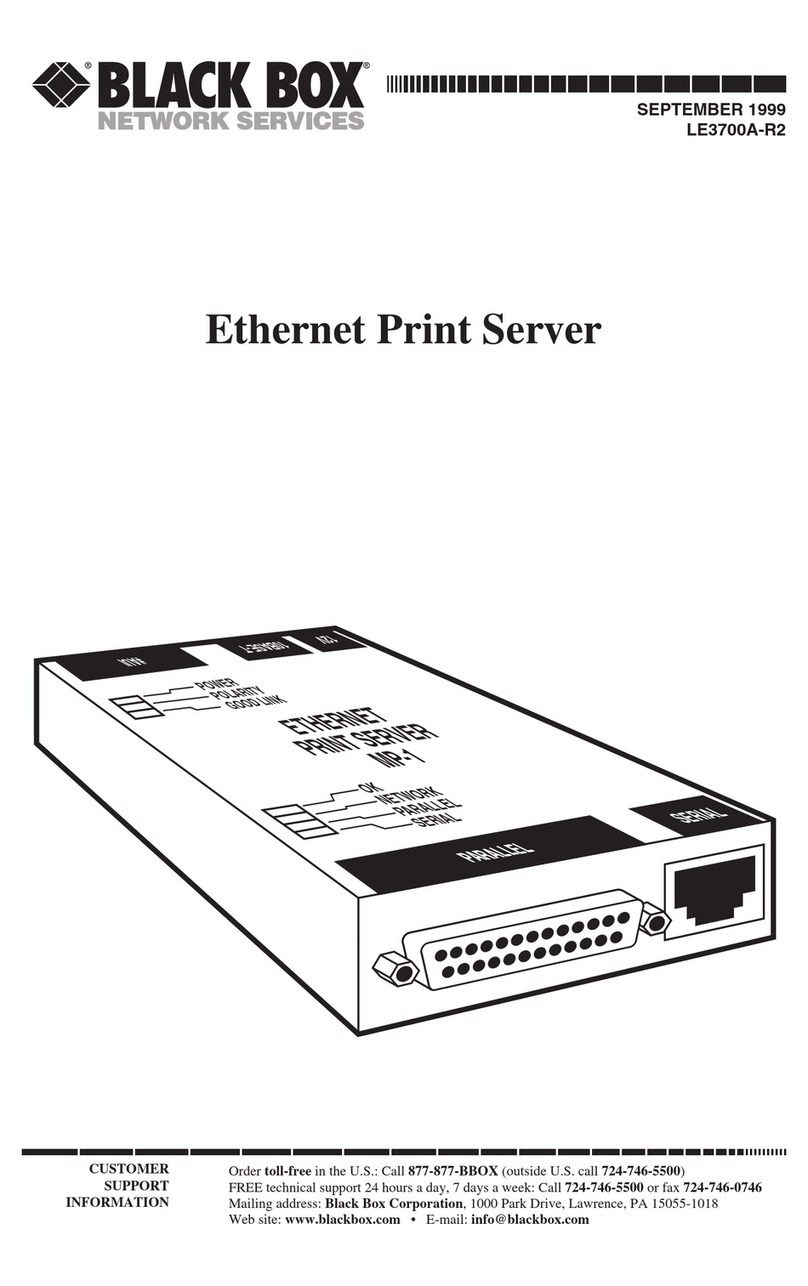
Black Box
Black Box LE3700A-R2 User manual
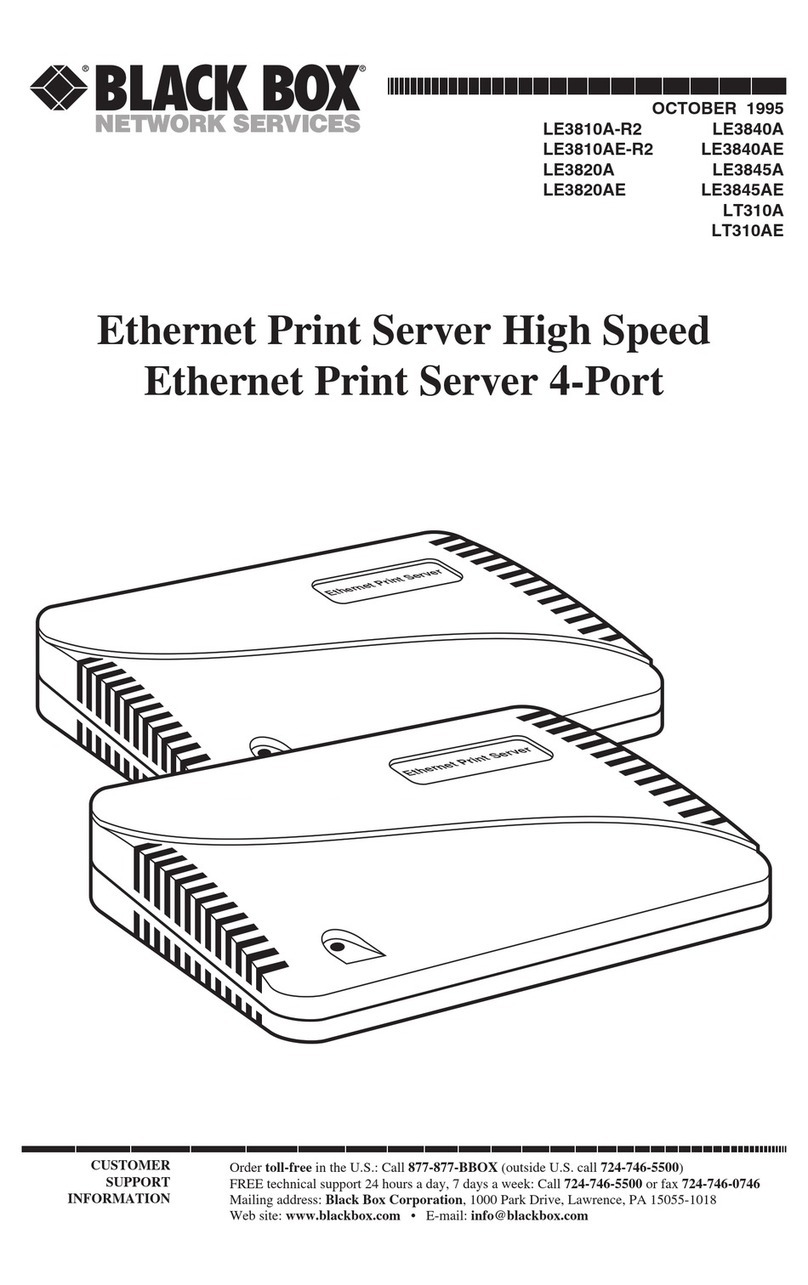
Black Box
Black Box LE3840A User manual
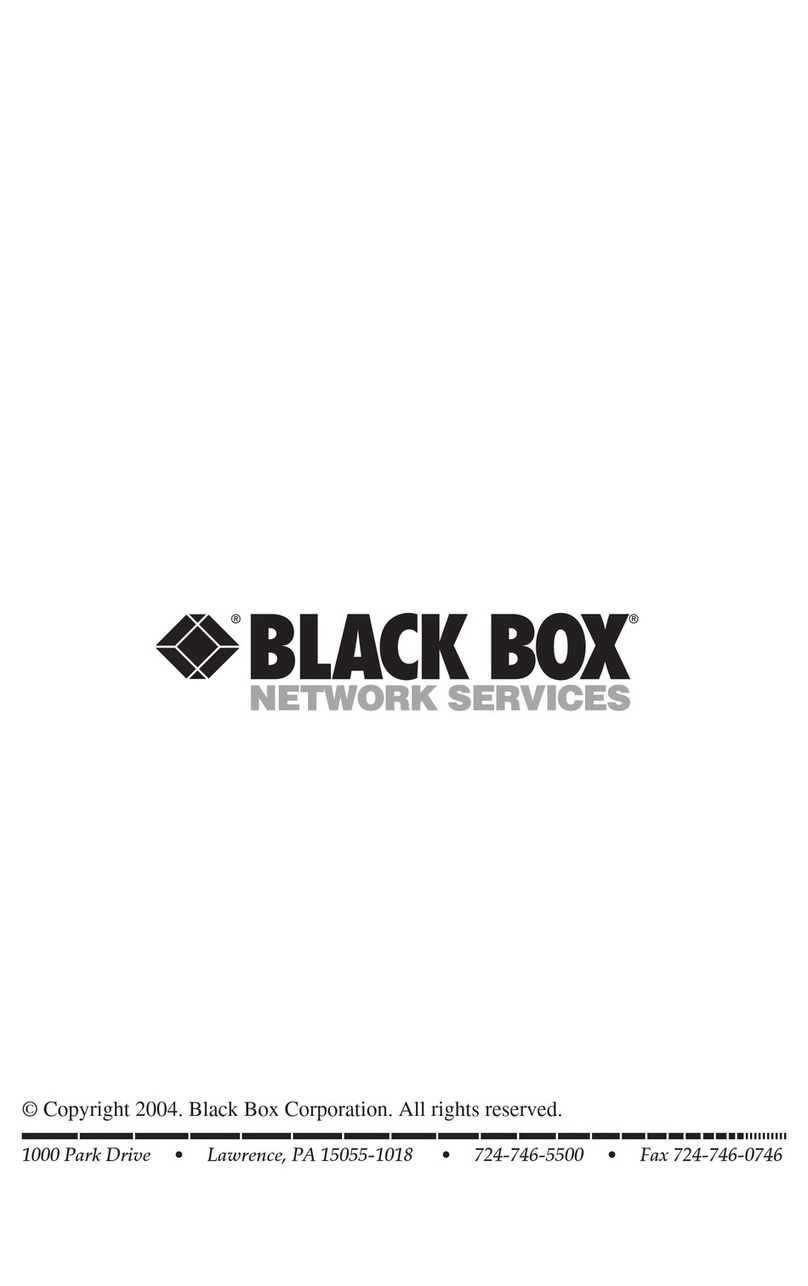
Black Box
Black Box LEP0000A User manual

Black Box
Black Box LEP0005A User manual
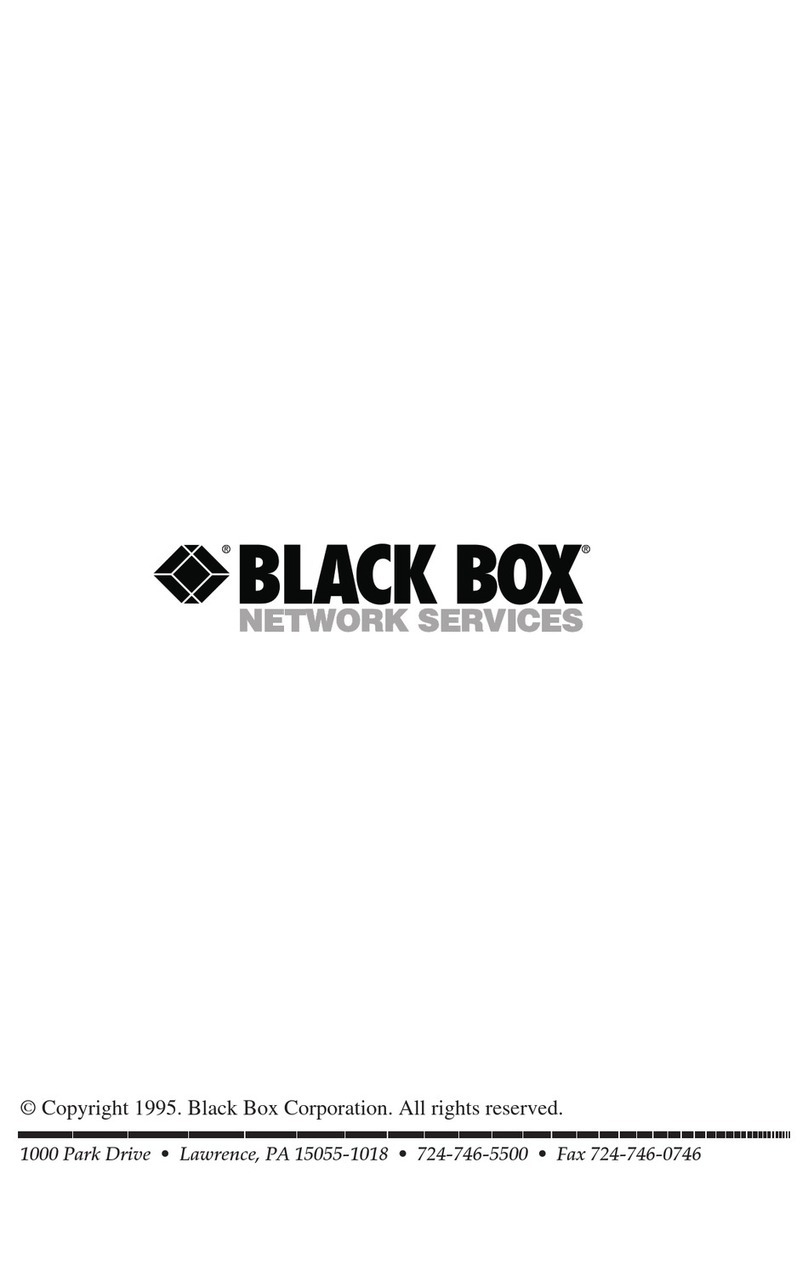
Black Box
Black Box TX/CX 4000 User manual
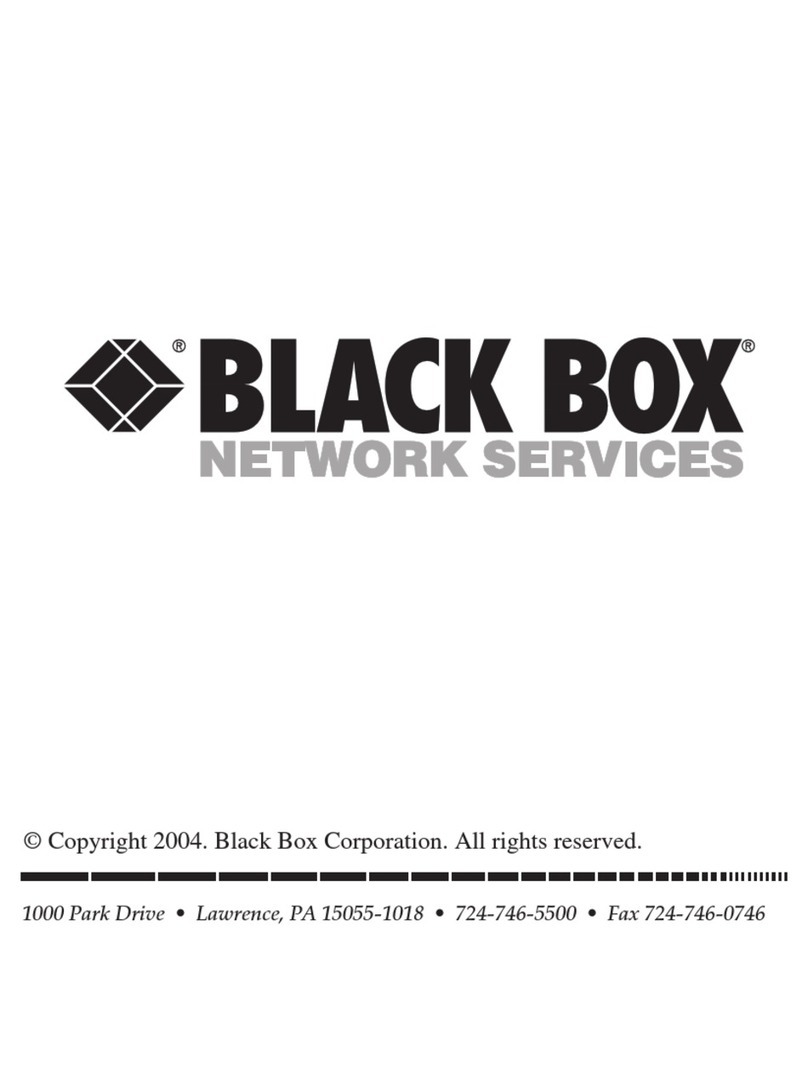
Black Box
Black Box Pure Networking 802.11b User manual

Black Box
Black Box LEP0002A User manual
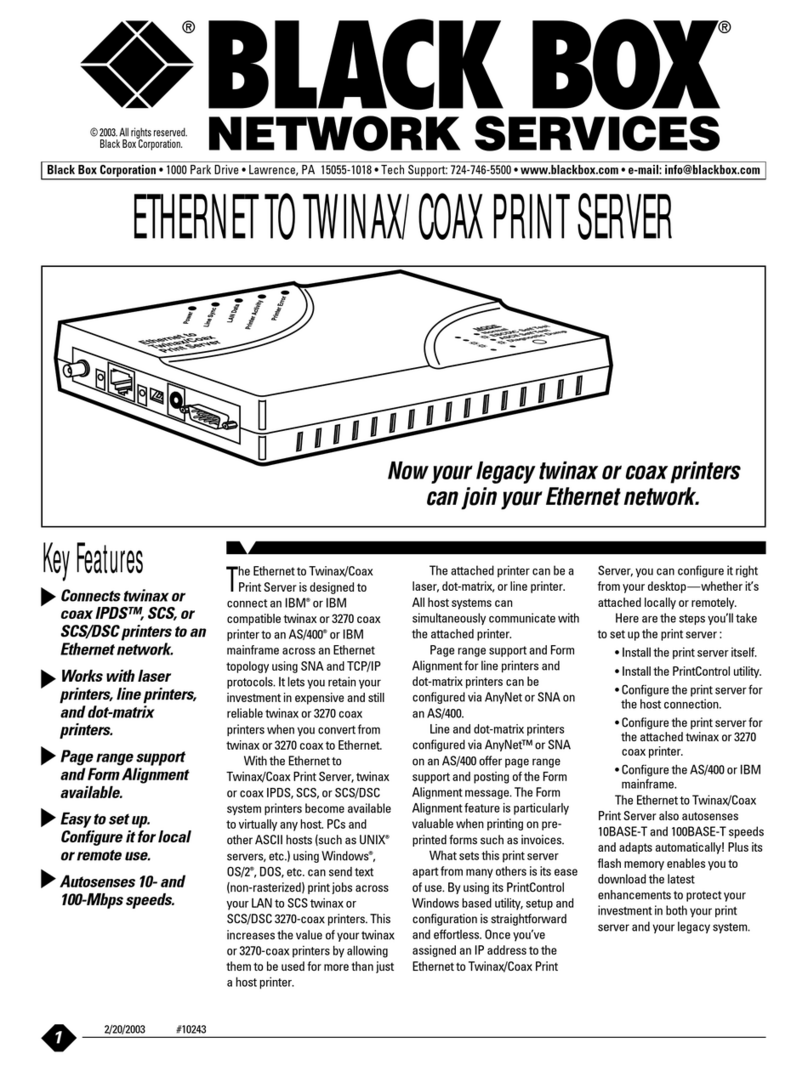
Black Box
Black Box PC435A User manual
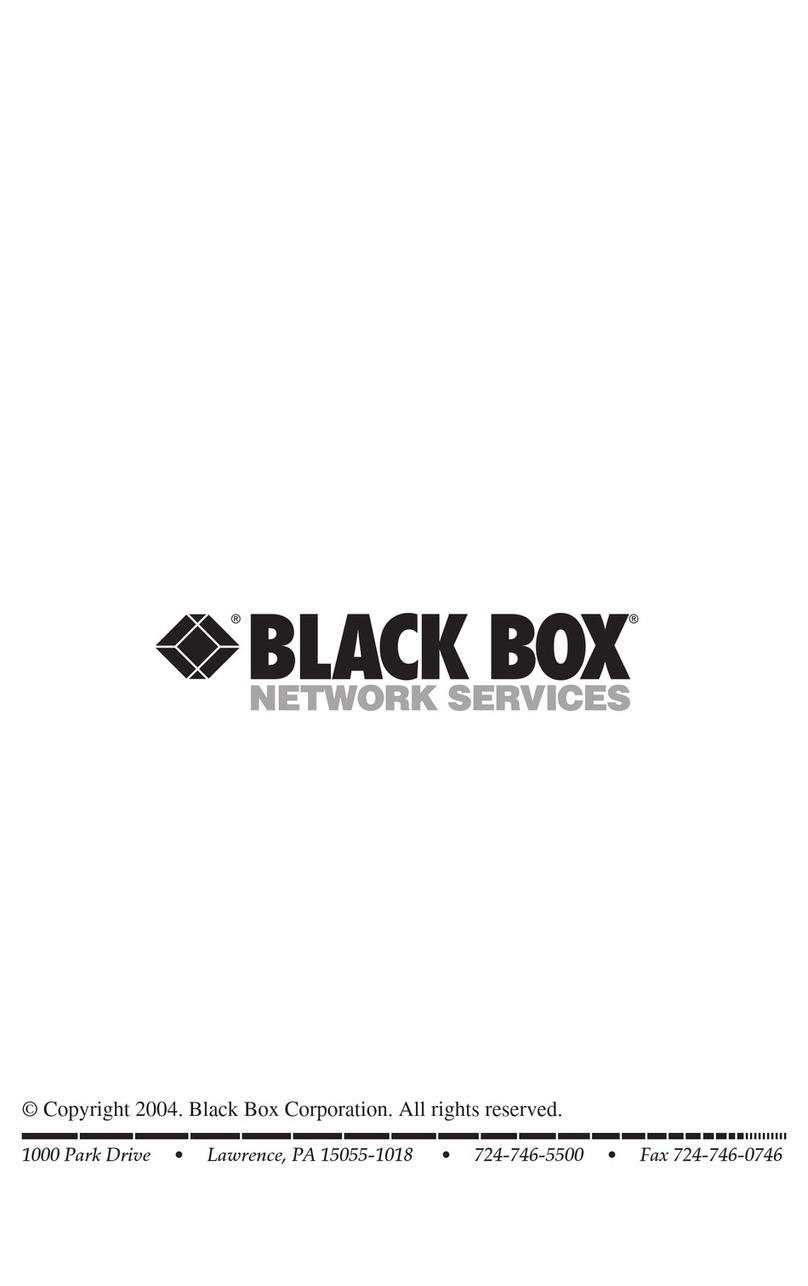
Black Box
Black Box LEP0005A User manual
